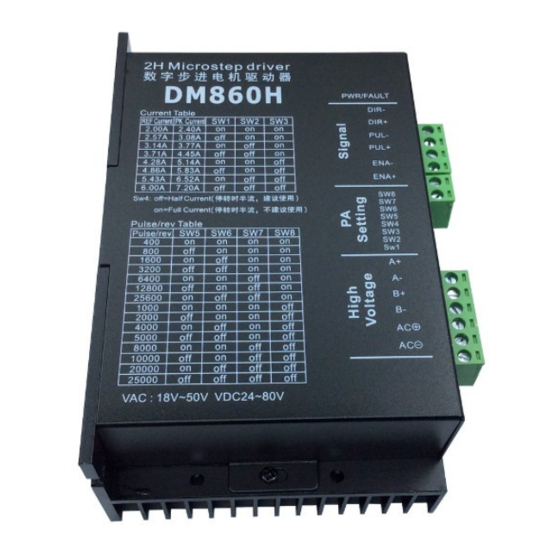
Table of Contents
Advertisement
Advertisement
Table of Contents

Subscribe to Our Youtube Channel
Summary of Contents for Leadshine DM860
- Page 1 User’s Manual DM860 Fully Digital Stepper Drive...
-
Page 2: Table Of Contents
Contents Table of Contents 1. Introduction, Features and Applications ........................1 Introduction ................................1 Features..................................1 Applications................................1 2. Specifications................................1 Electrical Specifications ............................1 Operating Environment and other Specifications .....................2 Mechanical Specifications ............................2 Elimination of Heat..............................2 3. Pin Assignment and Description...........................3 Connector P1 Configurations ...........................3 Selecting Active Pulse Edge or Active Level and Control Signal Mode ..............3 Connector P2 Configurations ...........................4 4. -
Page 3: Introduction, Features And Applications
1. Introduction, Features and Applications Introduction The DM860 is a fully digital stepper drive developed with advanced DSP control algorithm based on the latest motion control technology. It has achieved a unique level of system smoothness, providing optimal torque and nulls mid-range instability. -
Page 4: Operating Environment And Other Specifications
DM860 Fully Digital Stepper Drive Manual V1.0 Operating Environment and other Specifications Cooling Natural Cooling or Forced cooling Avoid dust, oil fog and corrosive gases Environment 0 ℃ - 50℃ Ambient Temperature 40%RH - 90%RH Operating Environment Humidity Operating Temperature ℃... -
Page 5: Pin Assignment And Description
3. Pin Assignment and Description The DM860 has two connectors, connector P1 for control signals connections, and connector P2 for power and motor connections. The following tables are brief descriptions of the two connectors. More detailed descriptions of the pins and related issues are presented in section 4, 5, 9. -
Page 6: Connector P2 Configurations
4. Control Signal Connector (P1) Interface The DM860 can accept differential and single-ended inputs (including open-collector and PNP output). The DM860 has 3 optically isolated logic inputs which are located on connector P1 to accept line driver control signals. These inputs are isolated to minimize or eliminate electrical noises coupled onto the drive control signals. -
Page 7: Connections To 6-Lead Motors
DM860 Fully Digital Stepper Drive Manual V1.0 Connections to 6-lead Motors Like 8 lead stepping motors, 6 lead motors have two configurations available for high speed or high torque operation. The higher speed configuration, or half coil, is so described because it uses one half of the motor’s inductor windings. -
Page 8: Parallel Connections
6. Power Supply Selection The DM860 can match medium and small size stepping motors (from NEMA frame size 17 to 34) made by many motor manufactures around the world. To achieve good driving performances, it is important to select supply voltage and output current properly. -
Page 9: Selecting Supply Voltage
DM860 Fully Digital Stepper Drive Manual V1.0 Selecting Supply Voltage The power MOSFETS inside the DM860 can actually operate within +24 ~ +110VDC, including power input fluctuation and back EMF voltage generated by motor coils during motor shaft deceleration. Higher supply voltage can increase motor torque at higher speeds, thus helpful for avoiding losing steps. -
Page 10: Dynamic Current Setting
DM860 Fully Digital Stepper Drive Manual V1.0 Since parallel and serial connections of motor coils will significantly change resulting inductance and resistance, it is therefore important to set driver output current depending on motor phase current, motor leads and connection methods. -
Page 11: Wiring Notes
DM860 Fully Digital Stepper Drive Manual V1.0 8. Wiring Notes In order to improve anti-interference performance of the driver, it is recommended to use twisted pair shield cable. To prevent noise incurred in PUL/DIR signal, pulse/direction signal wires and motor wires should not be tied up together. -
Page 12: Sequence Chart Of Control Signals
DM860 Fully Digital Stepper Drive Manual V1.0 10. Sequence Chart of Control Signals In order to avoid some fault operations and deviations, PUL, DIR and ENA should abide by some rules, shown as following diagram: Figure 11: Sequence chart of control signals... -
Page 13: Frequently Asked Questions
DM860 Fully Digital Stepper Drive Manual V1.0 12. Frequently Asked Questions In the event that your driver doesn’t operate properly, the first step is to identify whether the problem is electrical or mechanical in nature. The next step is to isolate the system component that is causing the problem. As part of this process you may have to disconnect the individual components that make up your system and verify that they operate independently.
















Need help?
Do you have a question about the DM860 and is the answer not in the manual?
Questions and answers